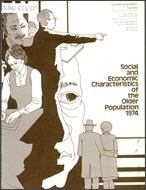Social and Economic Characteristics of the Older Population: 1974
Social and Economic Characteristics of the Older Population: 1974
Introduction
This report brings together, in a single publication, a variety of social and economic characteristics of the older population. Many of these statistics have already been published in Census Bureau and other governmental publications and are now being brought together as a matter of convenience to the interested user, but some data are being presented here for the first time. The data in this report are primarily from the 1970 census and the March 1974 Current Population Survey.
For purposes of this report, the "older" population is defined as the population 65 years old and over. The lower limit has been arbitrarily placed at 65 years in recognition of a number of factors which, over the years, have combined to make the attainment of age 65 a milestone—for example, a time for retirement, Social Security benefits and Medicare coverage, income tax advantages, and reduction in transit fares and admission prices. This is also an age group which has come to be identified with low income, widowhood, and loneliness. In some tables, comparative statistics are shown for segments of the population below age 65 as well, particularly the 55 to 64 year olds. In a number of areas, especially those of an economic nature, there are dramatic differences between the age groups 55 to 64 and 65 and over. For many persons, the 10 years prior to their 65th birthday represent their peak years—or high plateau years—of earning power and of income per family member; in sharp contrast, this period is followed by the reduced income of their retirement years.
There are striking differences in a number of areas among segments of the elderly and between the elderly and the younger adult population. There are also similarities in some facets of their lifestyle. These similarities and differences are explored in relation to such characteristics as family and marital status, institutional population, nativity and parentage, mobility, residence, educational attainment, vocational training, voting rates, veteran status, labor force participation, occupation and industry, income and earnings, low-income status, housing, factors relating to health and to the utilization of health services, and crime victimization.
A Note on Language
Census statistics date back to 1790 and reflect the growth and change of the United States. Past census reports contain some terms that today’s readers may consider obsolete and inappropriate. As part of our goal to be open and transparent with the public, we are improving access to all Census Bureau original publications and statistics, which serve as a guide to the nation's history.
Others in Series
Publication
Publication
Publication




